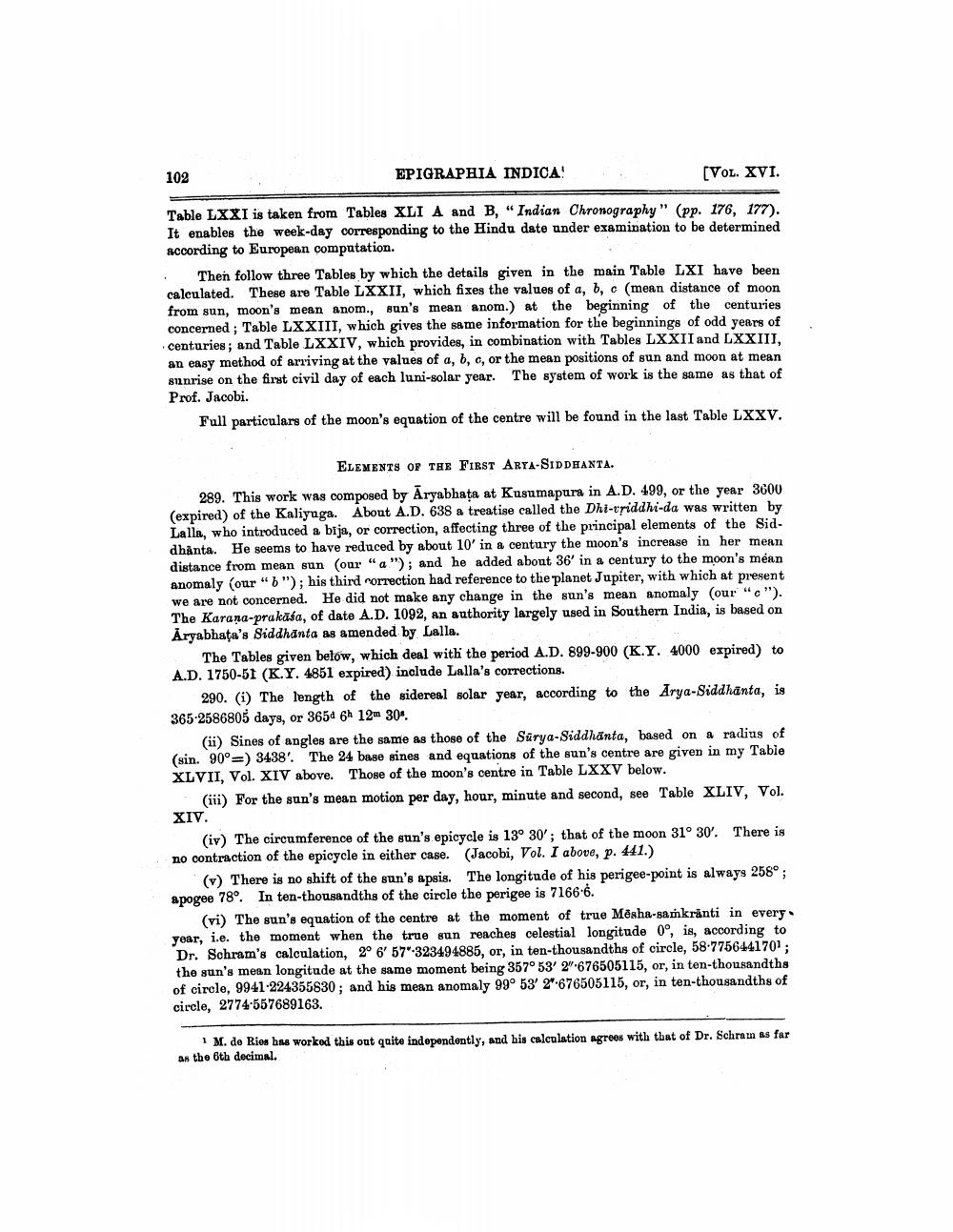________________
102
EPIGRAPHIA INDICA!
(VOL. XVI.
Table LXXI is taken from Tables XLI A and B "Indian Chronography" (pp. 176, 177). It enables the week-day corresponding to the Hindu date under examination to be determined according to European computation.
Then follow three Tables by which the details given in the main Table LXI have been calculated. These are Table LXXII, which fizes the values of a, b, c (mean distance of moon from sun, moon's mean anom., sun's mean anom.) at the beginning of the centuries concerned ; Table LXXIII, which gives the same information for the beginnings of odd years of centuries; and Table LXXIV, which provides, in combination with Tables LXXII and LXXIII, an easy method of arriving at the values of a, b, c, or the mean positions of sun and moon at mean sunrise on the first civil day of each luni-solar year. The system of work is the same as that of Prof. Jacobi.
Full particulars of the moon's equation of the centre will be found in the last Table LXXV.
ELEMENTS OF THE FIRST ARYA-SIDDHANTA. 289. This work was composed by Aryabhata at Kusumapara in A.D. 499, or the year 3600 (expired) of the Kaliyaga. About A.D. 638 a treatise called the Dhi-tsiddhi-da was written by Lalla, who introduced a bija, or correction, affecting three of the principal elements of the Sid dhånta. He seems to have reduced by about 10' in a century the moon's increase in her mean distance from mean sun (our "a"); and he added about 36' in a century to the moon's méan anomaly (our " "); his third rorrection had reference to the planet Jupiter, with which at present we are not concerned. He did not make any change in the sun's mean anomaly (our "c"). The Karana-prakala, of date A.D. 1092, an authority largely used in Southern India, is based on Aryabhata's Siddhanta as amended by Lalla.
The Tables given below, which deal with the period A.D. 899-900 (K.Y. 4000 expired) to A.D. 1750-51 (K.Y. 4851 expired) include Lalla's corrections.
290. (i) The length of the sidereal solar year, according to the Arya-Siddhanta, is 365-2586805 days, or 365d 6h 12m 30.
(ii) Sines of angles are the same as those of the Sürya-Siddhanta, based on a radius of (sin. 90°=) 3438'. The 24 base sines and equations of the sun's centre are given in my Table XLVII, Vol. XIV above. Those of the moon's centre in Table LXXV below.
(iii) For the sun's mean motion per day, hour, minute and second, see Table XLIV, Vol. XIV.
(iv) The circumference of the sun's epicycle is 13° 30'; that of the moon 31° 30'. There is no contraction of the epicycle in either case. (Jacobi, Vol. I above, p. 441.)
(v) There is no shift of the sun's apsis. The longitude of his perigee-point is always 258°; apogee 78°. In ten-thousandths of the circle the perigee is 71666.
(vi) The sun's equation of the centre at the moment of true Mösha-sankranti in every year, i.e. the moment when the true sun reaches celestial longitude 0°, is, according to Dr. Schram's calculation, 2° 6' 57"-323494885, or, in ten-thousandths of circle, 58-775644170); the sun's mean longitude at the same moment being 357° 53' 2"676505115, or, in ten-thousandths of circle, 9941-224355630; and his mean anomaly 99° 53' 2676505115, or, in ten-thousandths of circle, 2774557689163.
1 M. de Ries has worked this out quite independently, and his calculation agrees with that of Dr. Schram as far as the 6th decimal.




